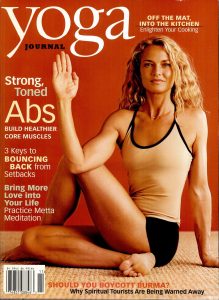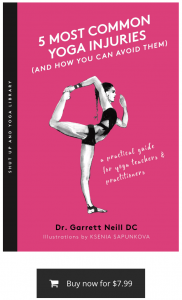On a scale of goat to ashtangi, how yogi are you?
There’s yoga out there that just isn’t my flavor, but I don’t have to declare it “not yoga” for everyone else in the community. I simply don’t practice it and let those who do to enjoy it without any judgment.
In the early years of my yoga practice, when Ashtanga was the only show in town, one of my teachers told the class that nothing in Yoga Journal magazine was real yoga.
For a while, I believed him, and I felt bad for enjoying the magazine. His words did nothing to support or deepen my connection to yoga – such attitudes make it hard to just show up at a studio as a yoga practitioner, and even more so as someone new to yoga. It sets the tone for them vs. us culture that is pervasive across society today.

More recently, I received a newsletter from a studio that explained what is and what is not yoga. It came complete with pictures of the styles that didn’t make the cut of approved yoga. To wholesale vilify a style of yoga is bananas, and it gets in the way of people connecting with the practice. If you teach yoga, if you own a studio, if you practice yoga and wish for it to thrive in the future, then we have to meet people where they are.
To quote the badass, pragmatic yoga pioneer, Beryl Bender Birch:
“You can’t start with the seventh limb. Yoga is an evolutionary process. It takes us from very, very gross levels of awareness to very sophisticated levels of awareness to incredible mindfulness. Yoga is about learning to pay attention. Goats aren’t any more or less of a distraction than music or babies or dogs or any of the other stuff that people drag into a yoga class. It’s a way to get started.” [Ref]
I took my first yoga class in 2001. It was an ashtanga class, but I had no idea what that meant at the time. I went to yoga for the same reason so many other people do – to move my body in a mindful way that would feel good and reduce stress. I wasn’t initially drawn to yoga for its spiritual roots, because I didn’t know that side of yoga existed.
More than ever people come to yoga to undo some of the effects of modern life – sitting, multitasking, and less movement and barefoot time.
This is where I meet people, reminding them to have reasonable expectations for their movement abilities. You don’t have to get it all done today. Our body and our breathing adapt to the positions and situations we spend the most time in. Finding sustainable versions of the posture or movement you are in, whether it’s triangle pose or sitting on the ground in a cross-legged seat.
Whether we try to or not, we are all co-creating this living tradition called yoga. We have encouraged friends, family, coworkers to try yoga as a way to improve our quality of life and as a result, yoga has bled into our other activities – yoga for runners, prenatal yoga and yoga in the workplace to name a few. Other disciplines have bled into yoga too, and why not? Invite them in.
Flow yoga has obvious elements of modern and free-form dance, Pilates shows up in alignment and core-focused yoga classes, while martial arts and strength-based practices show up in power yoga.
Movement science has come a long way since some of our favorite yoga postures were first sequenced. We can be better, more informed practitioners and teachers if we adapt and grow with these discoveries. We can meet people where they are if we stop simultaneously inviting everyone to do yoga and then telling them they’re not really doing yoga when they show up.
Three years ago I met a woman at a Yoga With Cats event. She borrowed a mat and took her first ever class with 50 other people and a bunch of adoptable cats. She’s now a regular at two studios I teach at. Events like this meet people where they already are in the community – a cat shelter, a brewery, a park, an art gallery. It provides those who don’t identify as yogis an opportunity to experience the essence of yoga – awareness, breath, movement all without having to go to an unfamiliar yoga studio where everyone is barefoot, breathing heavy and wearing spandex. The pressure is off, and the invitation to move and breathe mindfully becomes clear. What’s not to love about that?

Life is messy which means so is yoga – let me make it more so. Do I have to adhere to the ethical code of the Patanjali sutras to qualify my yoga? Do I have to study, quote, and teach the 8-limb path for it to be authentic, real yoga? I don’t think so. I came to yoga to feel better in my body and calm my mind. I was looking to build awareness.
I can do that with the help of ancient yoga texts, and I can do it without them too. I don’t have to back up a hard pose with a spiritual quote. I don’t need my yoga to be traditional, ancient, delivered in Sanskrit or backed by a guru.
However, if it’s being emphasized that yoga is more than just postures, then teachers have to stop passively adjusting people into deeper versions of poses that they’re told aren’t the focus or goal of the practice. At best, it’s a frustrating mixed message when teachers mold a students body either through words or physical touch to achieve a certain alignment aesthetic. There’s a disconnect. The better the pose is expressed, the better the person. I’m not the first to observe this – there are some really advanced bendy yogis who are also really advanced bendy jerks.
This debate in yogaland feels reminiscent of the saying, “if you don’t like gay marriage, don’t get gay married.” If you don’t like aerial yoga, hot yoga, cat yoga, gym yoga or yoga void of limbs and sutras then don’t do those styles of yoga; it can still be yoga to someone else. Trust and love your yoga so much that instead of becoming rigid and set in your identity to it, you become more adaptive and open to its modern interpretations. The way we practice yoga is already wildly different from Patanjali’s time anyway.
I’d like to offer a call-up and say, don’t worry, your yogi identity is not under threat because people are doing sun salutations next to goats.
How’s the dialogue you have around what is and isn’t yoga affecting your own practice? Is that not at all interfering with your own self-acceptance on the mat? We have more important work to do in our yoga communities. That energy used to climb to the top of the that’s not real yoga mountain – you can use it instead to:
1. Make yoga more accessible, more inviting, welcoming, less intimidating: who’s not at your yoga studio? Why not?
2. Make yoga more sustainable: discover and encourage movement that supports the ways we move in real life. Stop worshipping passive flexibility. Stop adjusting students into deeper passive ranges. Provide, use and teach with props.
3. Be a yogi/teacher more informed and skilled in their scope of practice: set up healthy boundaries around what you teach. You’re not a health care provider unless you are, in which case you don’t practice in a group setting during a yoga class.
4. Find ways to eradicate behaviors and systems that foster shame and fear and allow sexual predators to thrive under the cloak of guru status: start having hard conversations. There is power in numbers. Speak up, speak out or support others who do. Believe survivors of abuse.
Yoga is ours. If we want it. Go make it so varied and diverse that everyone else wants it too.

Illustration by Ksenia Sapunkova
Edited by Ely Bakouche



